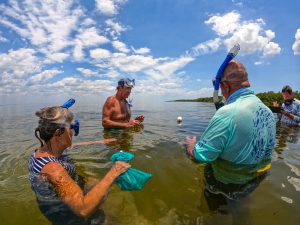Citizen scientists help preserve seagrasses in the Panhandle and Southwest Florida through a program called Eyes on Seagrass, which now has a dedicated webpage where potential volunteers can learn more.
The efforts of the people who give their time are so successful, UF/IFAS Extension and Florida Sea Grant are expanding the program. It began in Escambia County in 2017 and spread to Santa Rosa County. Citizen scientists started collecting samples in Charlotte County in 2019. They’re now in Sarasota County and will likely be in Lee County in 2024.
“Without the volunteer help, state agencies would not be able to amass all this data on their own,” said Kate Rose, Florida Sea Grant agent for UF/IFAS Extension Charlotte County. “The program was one of the first to start collecting data on seaweed, which first appeared consistently in Charlotte Harbor in 2012 and has more recently been connected to seagrass loss.”

Numbers tell the story of general public interest in participating. Charlotte County’s program started with 28 volunteers and now has 102. Escambia County began with three volunteers and now has 19.
Volunteers are eager to collect data, and the information they collect is invaluable. A bonus? The data are valid. Their collection methods were developed in close collaboration with UF/IFAS scientists to ensure the data can be utilized in assessments by natural resource managers.
In addition to helping collect data on seagrass, Rose touts a number that reflects engagement from those volunteers — 82% took additional action. As examples, they educated others about the importance of seagrass, advocated to conserve the habitat and made efforts to reduce seagrass scars via their boat propellers.

“My wife and I have come to appreciate what a magnificent resource the Charlotte Harbor Estuary is,” said Rick Sluzewski, a volunteer in Charlotte County. “Having an opportunity to actively participate in the ‘Eyes on Seagrass’ survey on our harbor has enriched my appreciation for this great resource and driven home the message that all who live in our area need to be active stewards assisting its professional guardians any way we can.”
When he started organizing Eyes on Seagrass in the Panhandle, Rick O’Connor found citizen scientists who would eagerly put a mask on and go out into the water.
“They’ve learned about the health of Pensacola Bay. They’ve watched it with protective eyes. I have nine citizens science projects, and many from Eyes on Seagrass volunteer on other projects,” said O’Connor, Florida Sea Grant agent for UF/IFAS Extension Escambia County.
Seagrasses act as a food source and a habitat for many commercially and recreationally important fish species. They also enhance water clarity, stabilize shorelines and sequester carbon and nitrogen. Seagrasses die with higher nutrient levels in water bodies. Charlotte Harbor saw a 23% loss in seagrass between 2018 and 2021.
Nutrients are a key factor in ensuring seagrasses remain or, in some cases, regain their health.
“We aren’t just looking for and documenting seagrass loss, in some parts of the state where the water is getting cleaner, seagrass are expanding,” said Laura Reynolds, a Florida Sea Grant-affiliated researcher and UF/IFAS assistant professor of soil, water, and ecosystem sciences. Reynolds analyzes the data sent to her by the volunteers.
The fewer nutrients go into any body of water, the healthier the seagrass is likely to be, the UF/IFAS experts say.
Eyes on Seagrass programs in Charlotte and Sarasota run in the spring and summer, but you can register any time. In Escambia County, volunteers collect samples in September, too.
Rose foresees great success in helping preserve seagrass though the program.
“Our citizen scientists have their eyes on seagrass,” Rose said. “With their help, we can do our best to make sure seagrasses are as healthy as possible. Going forward, I think that excitement will generate a really big data set. We’re only going to gain more credibility.”
Click here to learn more about Eyes on Seagrass.
To register for the Southwest Florida Eyes on Seagrass program, contact Rose at kate.rose0210@ufl.edu. For the Panhandle program, contact O’Connor at roc1@ufl.edu.
###
ABOUT UF/IFAS
The mission of the University of Florida Institute of Food and Agricultural Sciences (UF/IFAS) is to develop knowledge relevant to agricultural, human and natural resources and to make that knowledge available to sustain and enhance the quality of human life. With more than a dozen research facilities, 67 county Extension offices, and award-winning students and faculty in the UF College of Agricultural and Life Sciences, UF/IFAS brings science-based solutions to the state’s agricultural and natural resources industries, and all Florida residents.
ABOUT FLORIDA SEA GRANT
Hosted at the University of Florida, Florida Sea Grant is a partnership with the State University System of Florida, the State of Florida, and the National Oceanic and Atmospheric Administration that supports research, education and outreach to conserve coastal resources and enhance economic opportunities throughout the state.
flseagrant.org | @FloridaSeaGrant
 2
2
